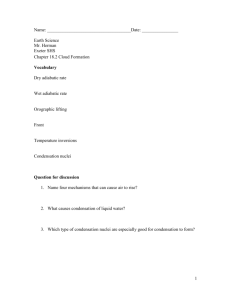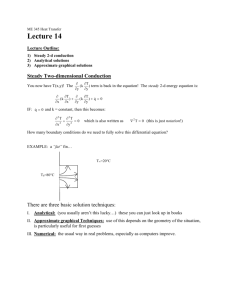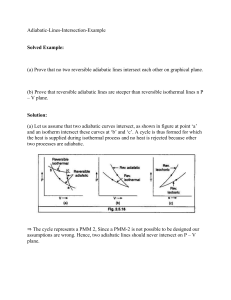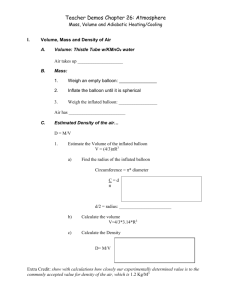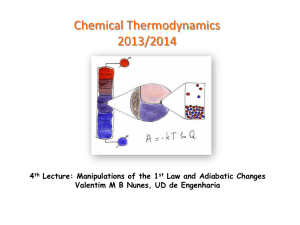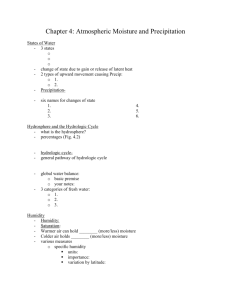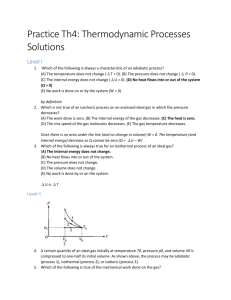Back Questions on the First Law of Thermodynamics
advertisement
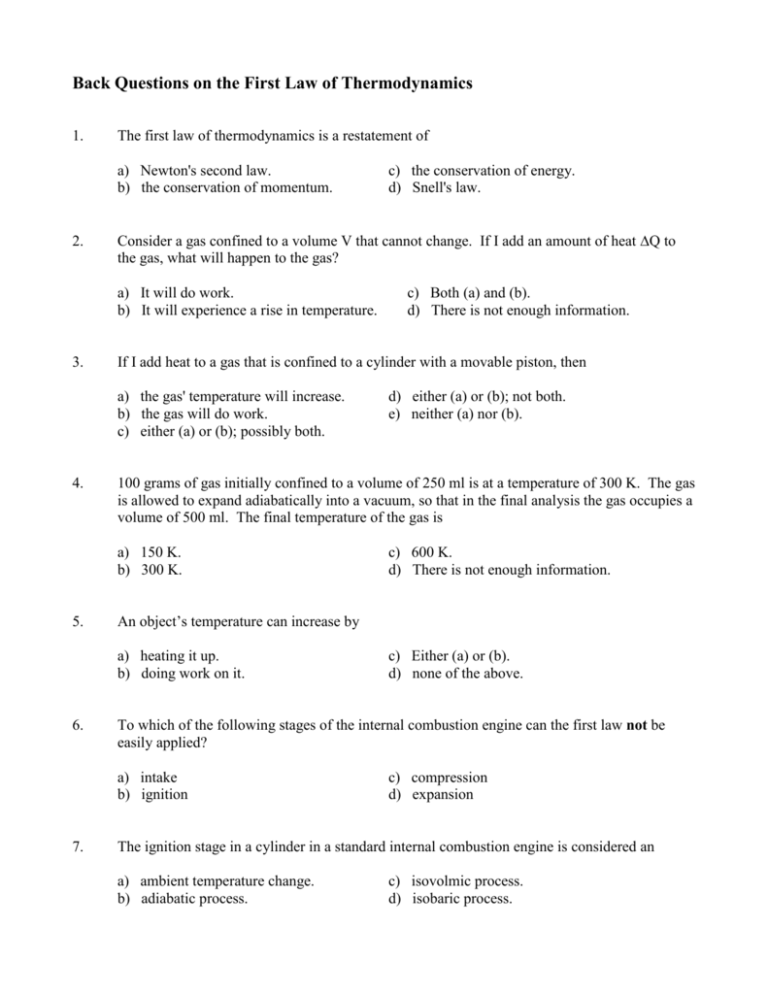
Back Questions on the First Law of Thermodynamics 1. The first law of thermodynamics is a restatement of a) Newton's second law. b) the conservation of momentum. 2. Consider a gas confined to a volume V that cannot change. If I add an amount of heat Q to the gas, what will happen to the gas? a) It will do work. b) It will experience a rise in temperature. 3. c) Either (a) or (b). d) none of the above. To which of the following stages of the internal combustion engine can the first law not be easily applied? a) intake b) ignition 7. c) 600 K. d) There is not enough information. An object’s temperature can increase by a) heating it up. b) doing work on it. 6. d) either (a) or (b); not both. e) neither (a) nor (b). 100 grams of gas initially confined to a volume of 250 ml is at a temperature of 300 K. The gas is allowed to expand adiabatically into a vacuum, so that in the final analysis the gas occupies a volume of 500 ml. The final temperature of the gas is a) 150 K. b) 300 K. 5. c) Both (a) and (b). d) There is not enough information. If I add heat to a gas that is confined to a cylinder with a movable piston, then a) the gas' temperature will increase. b) the gas will do work. c) either (a) or (b); possibly both. 4. c) the conservation of energy. d) Snell's law. c) compression d) expansion The ignition stage in a cylinder in a standard internal combustion engine is considered an a) ambient temperature change. b) adiabatic process. c) isovolmic process. d) isobaric process. 8. In an adiabatic process (with a gas), which of the following definitely occurs? a) b) c) d) 9. If a gas undergoes an adiabatic process, a) b) c) d) 10. The internal energy of the gas remains constant. If the gas expands, it warms up. The gas does not exchange any heat with its environment. The volume of the gas remains constant. the total internal energy of the gas remains constant. any change of the internal energy of the gas manifests itself as a change in the gas’ volume. the gas does not do any useful work. it cools down. Which of the following is (are) necessary for a gas to undergo an adiabatic process? a) The gas cannot change its volume. b) The container that the gas is in is well insulated. c) The process occurs "quickly". 11. Processes involving the motion of air masses are generally considered to be a) orographic. b) isovolmic. 12. c) lower . . . higher d) lower . . . lower As altitude increases, the ambient pressure and the ambient temperature a) decrease. b) increase. 14. c) adiabatic. d) isobaric. As altitude increases the ambient pressure gets ___________ and the ambient temperature gets _____________. a) higher . . . higher b) higher . . . lower 13. d) (b) or (c) but not (a). e) (a) or (b) or (c). c) remain constant. d) vary inversely. Which of the following depends on local surface conditions? a) The dry adiabatic rate. b) The wet adiabatic rate. c) The lapse rate. d) None of the above. 15. The lapse rate at a certain point of the earth will depend on a) the temperature at the top of the atmosphere. b) the temperature at the surface of the earth. 16. If the ground temperature is 35C and the top of the troposphere (12 km up) is 56C, then the lapse rate at this point is a) 4.7 C / 1000 m. b) 7.6 C / 1000 m. 17. c) 2.9 C / 1000 m. d) None of the above. A rising dry air mass will experience _______ in temperature and ________ in pressure. a) a rise . . . a drop b) a rise . . . no change 18. b) the same as adiabatic expansion is taking place in both a wet and dry air mass. condensation competes with the warming that takes place due to adiabatic expansion. convection competes with the cooling that takes place due to adiabatic expansion. condensation competes with the cooling that takes place due to adiabatic expansion. Although in class we gave an absolute number for the wet adiabatic rate, this number can actually vary, and this variance depends on (and don't groan, we did talk about this!) a) whether it is raining or not. b) the dry adiabatic rate. 21. c) the moisture content of the air mass. d) the lapse rate. A stable air mass generally results in a weather system characterized by ________ pressure. a) adiabatic 22. c) greater than The best reason for your answer to the previous question is a) b) c) d) 20. c) no change . . . a drop d) a drop . . . a drop The wet adiabatic rate is __________ the dry adiabatic rate. a) smaller than 19. c) both (a) and (b). d) neither; it is 6.5 C/1000 meters. b) ambient c) high d) low Absolutely unstable air can be responsible for a) cold fronts. b) warm fronts. c) thunderstorms. d) convergent systems. 23. This type of air mass can cause copious amounts of precipitation only if it is forcefully lifted: a) absolutely stable. b) conditionally stable. 24. In order for a conditionally unstable air mass to generate precipitation, a) b) c) d) 25. the air mass must be forcibly lifted. the air mass must begin to rise from the ground at the wet adiabatic rate. the air mass must be cloudy from the very beginning. the wet adiabatic rate must be less than the dry adiabatic rate. This is not a method of forceful lifting: a) convergence. b) orographic lifting. 26. c) conditionally unstable. d) absolutely unstable. c) updrafts. d) cold front. The Hawaiian Islands are surrounded by water (of course) and dominated by mountains. Which type(s) of forceful lifting could cause precipitation in Hawaii? a) Convergence. b) Orographic lifting. c) Frontal lifting. d) (a) and (b) but not (c). e) (a) and (b) and (c). In questions 27 - 30, choose your answer from the following: a) convergence b) orographic lifting c) condensation d) frontal movement 27. Which is not a standard method of forceful lifting? 28. Rainshadow deserts are generally caused by this. 29. This causes the difference between the rise of wet air and the rise of dry air. 30. This type of lifting can occur in practically any geographical location. 31. All things being equal, in the continental United States, a mountain range associated with orographic lifting will be found to the _____ of its associated rainshadow desert. a) North b) South c) East d) West 32. An occluded front occurs when _________ catches up to, and collides with, a ________. a) cold front . . . warm front. b) warm front . . . cold front. 33. c) cold air mass . . . warm air mass d) warm air mass . . . cold air mass. Which type of forceful lifting is responsible for tornadoes in the "Tornado Alley" region of the U.S.? a) Convergence. b) Orographic Lifting. c) Condensation. d) Frontal Lifting. Answer Key: 1. C 2. B 3. C 4. B 5. C 6. A 7. C 8. C 9. B 10. D 11. C 12. D 13. A 14. C 15. C 16. B 17. D 18. A 19. D 20. C 21. C 22. C 23. C 24. A 25. C 26. E 27. C 28. B 29. C 30. D 31. D 32. A 33. A

